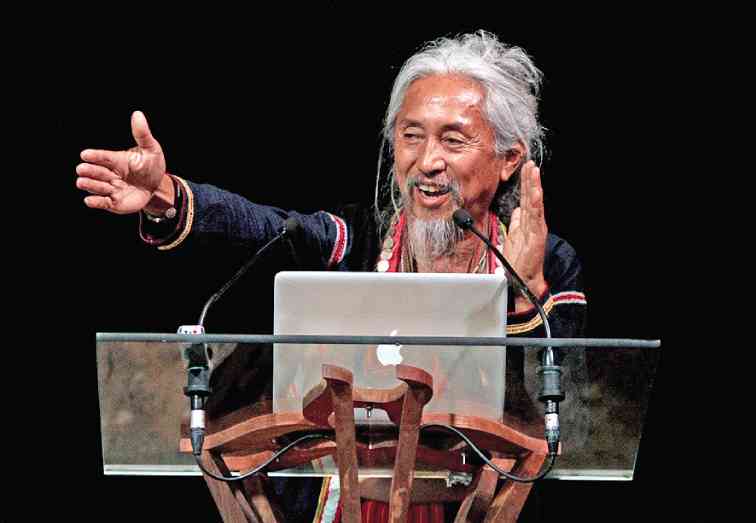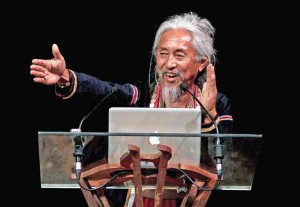
Mama, this great guy toppled a dictatorship in South Africa.” My finger pointed to a front-page portrait of Nelson Mandela in mutual-admiration gaze with Cory Aquino. My 97-year-old mother had to be guided through a maze of memory bytes.
“He was very aware of our own nonviolent transition to democracy,” I added. “Inspired si Mandela by our unique Pinoy kapuwa-pakikibaka spirit at Edsa.”
I gestured to Mama the Laban palm signal, wishing that within her nonagenarian recall a picture was worth the thousand words. Her childlike smile signaled she had made the cognitive bridge to the early 1980s, a time when we ran around Baguio with sunflowers, our indigenous flavored pakikibaka in those furious yellow days.
Maalaala mo kaya? I wondered as I read aloud to Mama, Conrad de Quiros’ tribute to Mandela and Cory: “They arose from such abject depths to topple regimes that seem destined to last forever—Cory came first, which was the writing on the wall about tyrants, having been weighed and wanting”—“Tinimbang Ka Ngunit Kulang” (surely a digression might titillate her almost-centenarian brain. Palibhasa, title ’yon ng film ni Lino Broka, ’di ba?”).
I saw the memory glowed in her eyes—to the ‘80s, when Lino sat across our dinner table during his Baguio location shoots, in the days of martial law.
My memories drifted to my 1977 visit to Apartheid-era Johannesburg—the light smiley banter at film fest cocktails… mixed with, yuck!, heavy interrogations inside a South African police station. Talagang halo-halo servings of Ni-Ha, Ni-Ho sentiments—as this Pinoy Indie filmmaker explored a different kind of Big Brother state—with a dramatic racial barcode—talagang B &W.
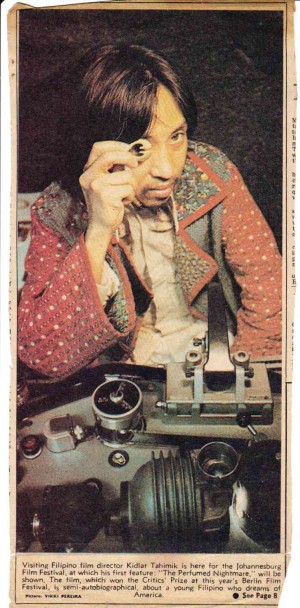
Ako? The visiting kayumanggi filmmaker? Ni-Black, Ni-White. Where do I stand? Hoy, pare ko, may middle kulay ang apartheid: “Colored.” That would have been my color-coding in apartheid… based on pigment…
Teka muna… how did Kidlat Tahimik get cast into this crazy colorfull (sic) film? (Yes Virginia, in the late ’70s there was a film entitled “Black and White: In Color.”)
June 1977. Berlin Film Festival. After the premiere of my movie, “Perfumed Nightmare,” South African playwright Athol Fugard congratulated me. He had also just premiered a film about a white South African farmer living in apartheid times.
His radical theater plays were monitored by authorities. But abroad, he was too respected. Short of outright censoring his plays, SA authorities made Athol a “banned” person (restricted travel; anybody who chatted with him got blottered by police).
He mentioned to me the Johannesburg film fest, hinting at a screening in his homeland.
Invitation by Fugard
September 1977. The postman delivered an invitation: Come to the land of apartheid, with all protocols of visa application spelled out. Another film fest, pero ang bigat!
It was the time of international boycotts to isolate the racist regime: foreign teams refusing to play the all-white soccer teams of South Africa; trade sanctions on SA exports; zero celebrity appearances; stop buying South African wine or diamonds.
My first impulse: Boycott! Don’t you dare show your film in that country.
Hoy! Teka muna! That was Athol Fugard, the anti-apartheid artist, who endorsed your film. (Athol, parang si Lino B. in Marcos’ time.) This was the celluloid-film era, before the digital-copy days, when festivals had to pay $250 freight to preview a film! Athol Fugard’s passion convinced the festival director, without viewing unknown filmmaker’s work, to screen your work.
Besides, the fest must be a gathering of truly anti-apartheid hearts and minds of SA society that questioned the racist fundaments of the white enclave. Why snub Athol, like many Ilustrado avoided Rizal in Dapitan?
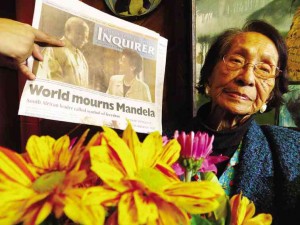
Curiosity took over. I knew little of rebel Nelson Mandela—“exiled” to Robben Island Prison. But, like other famous rebels, his cause was championed by the world press. So J’burg or bust! Sugod mga kapatid!
September 1977. My visa approval arrived from Pretoria by diplomatic pouch. (Wala pang e-mail noon!) Wow! My visa category was “Honorary White”! This was a privilege given to Japanese businessmen only, palibhasa economic heavyweights, no restrictions as Black/ Coloureds.
October 1977. Four months after the world premiere in Berlin of “Perfumed Nightmare,” Kidlat Tahimik found himself before an all-white audience in a J’burg cinema. I tried to insist on “no race barriers” to spectators. Compromise: They would allow “Coloureds” and… wow! Indians. (See film festival schedule on page D2.)
Yes, it was the usual glitter-glam of Tinseltown. The usual red carpet: tsunami of smiles greeted by paparazzi flashes. Comfty were we, in the “raceless” protocols of a celebrity gathering—oblivious to the realities of Soweto and Sharpeville suburbs outside.
Two days after the festival closed, a South African artist Ric and I were in a yellow Beetle southward to Durban to visit Athol Fugard. As a banned person, he could not travel to the Johannesburg film fest. So, why not visit the fighting fish—in his aquarium?
Questioned by police
Flashback: My tourist camera wasn’t a Nikon armed with a telephoto lens. It was a cheap Instamatic with limited depth-of-field capacity. Soon I was to realize the shallowness of my personal depth-of-field—re police-state protocols.
We pulled-off the highway into a lot with several fruit stands (like along Macarthur Highway, locals selling pakwan or dalanghita or bananas.) Negotiating with a family of black fruit vendors, I pulled out my Instamatic and started shooting. A white family buying at the next stall watched as I gregariously chatted with the vendors. As the family drove back into the highway, I jotted down the fruit growers’ mailing addresses to send pictures (wala pang FB noon.) T’was an innocent by-the-road-banter.

Back on the road, while I was relishing a watermelon, a Land Rover overtook us. A loudspeaker blurted, “Pull over, Sir.” The order: “Follow us, please”.
We chased the “Police” sign emblazoned on the back of the jeep onto the next town. Somebody had reported our “highly suspicious” interactions with the black. Wow praning!
We were interrogated by the superior. Why had I taken pictures? What was I talking to the blacks about? Why was I taking their address?
Luckily I was not “armed” with my Bolex 16mm. or the SA SWAT team would have swooped down on my 16mm shooter.
Ninety minutes later, we were released. OK, they’d been courteous. But cold, with a racial standoffishness.
But it’s a memory that chills me even today. Those adrenalin spurts had brutalized me even if there were no physical threats. Martial law memories of Manila came floating in.
It was like Mandela’s tale of arriving at Robben Prison when he counter-intimidated a white warden: “Don’t touch me. I’m a lawyer.” The brute backed off.
Mandela got none of the blows that welcomed other blacks. But the intimidation wore him down.
After that, I felt like a banned person, not free to chat up natives on the road. But I got interesting photos: garden sculptures of Snow White surrounded by black dwarfs with picks. (Microcosm of SA elite circled by diamond miners?)
Also high-contrast pics: silhouettes of black drivers in their trucks against white fog, like black angels speeding through clouds of white.
Unfortunately all my negatives burned when my house was gutted by the fire of 2004. Black framings into black ashes.
Black homeland
But one super-memory survives my melted negs. It contextualizes my whole stay: We drove to Transkei—a “state” the apartheid regime exhibited to the world as an “Independent Black Homeland.” A perfumed label—“separate races, separate development”—to disguise the nightmare of apartheid. Getz?
It was the first anniversary of “Transkei Independence.” We drove through the brown and green landscapes dotted with clusters of huts, surrounded by cows.
On the narrow dirt “highway” we encountered a young shepherd with his goat groupies. Since we were in “independent” black country, we didn’t fear further SA police interventions. The boy wore a beaded necklace with brass memorial medals attached: “Transkei Independence Day—October 1976”—exactly one earlier.
My friend Ric offered to pay 10 rands for one medal. This irked me: “Ric, money is so ephemeral. Offer him something of value to you as he is parting with something of value to him.”
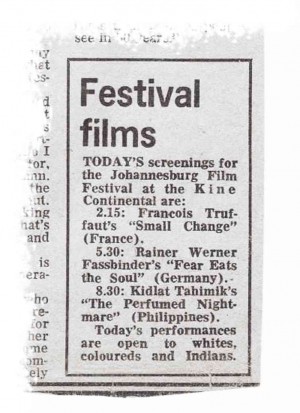
Feeling guilty, Ric offered his silver crucifix necklace. The boy shook his head. His eyes scrolled down from the shiny cross to a red button pinned on the lapel of Ric’s shirt. He pointed to the “Avis—We Try Harder” button.
Of course, I knew rent-a-car freebies were worth next to nothing. But if it was valuable to the boy, it was a fair exchange.
Ric probably got the point. But it was hard to discuss what constitutes “fair” exchange in a land where race dictated the level of wages. The deep reason for apartheid was the exchange of enormous blood/sweat/tears for just a handful of cash.
Miner’s song
That reminded me of the miners’ song “16 Tons of #9 Ore.” A country with a booming supply of cheap labor was facing a booming demand for diamonds and gold outside. That was the convenient truth of apartheid. It was not a separate development of the races. It was a constitutionally sanctioned separate economic development strategy. Meaning: Slave wages went to the black labor force. And, separately, the white economy got the difference (super profits) from the world price of gold.
Play it again, Sam: the miner’s “16 Tons” refrain…
“Some people think a man’s made out of mud…
A poor man is made out of muscle and blood…
A mind that’s weak and a back that’s strong…
You load 16 tons of #9 ore…
Another day older and deeper in debt…
I owe my (black) soul to the (white) company store…”
That song kept ringing in my head as we reached beautiful Durban, overlooking the sea. Port Elizabeth was teeming with black stevedores. We saw nonstop traffic of ships (gold?/diamonds?) headed to rich trading centers in the northern hemisphere.
Mandela’s relevance
Flash forward 36 years later: Dec. 15, 2013. Live coverage of Mandela’s funeral was in full swing on CNN. As the Xhoso choir sang a tribal dirge, a scheduled massage by my blind masseuse was in full swing.
Eden, who couldn’t watch TV, had no idea for whom the final honors were all about. It was easy to explain to a blind person the dramatic black-race-vs-white-race conflicts that propelled Mandela’s destiny. How to explain the political nuances was more difficult.
Soon I found an example: gender discrimination. Once upon a time, Eden, women could not vote. Confined to the home, they had no economic power—which meant no voting rights. Not until 1937.
To give flesh to the issue, I told her of my mother, Virginia Oteyza, who, with Carmen Planas, campaigned in 1936 for women’s suffrage. Mama visited the gold mines around Baguio to explain to the miners the injustice of not allowing women to vote.
“Parang ganoon din sa South Africa, based on your race, you could not vote leaders. Palibhasa only whites could vote. Lumaban si Mandela until blacks could vote in 1994. “Ahhh, alam ko na.” said Eden. “Hindi dapat ma-penalize kasi they were born different.” Eden was aware she was born blind. “Ganoon pala. Nakikita ko na.”
Dec. 16. Breakfast. I finished reading to Mama the tribute of De Quiros to the black giant who mastered the art of forgiveness to his jailers: “If Mandela had chosen a more vindictive path, SA would have been locked in strife with no end to bloodletting. But he did not call for forgetting.”
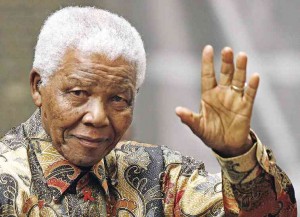
Despite the dementia of my favorite nonagenarian, she somehow connected the dots of De Quiros: “If people could be taught to hate, Mandela said, they could be taught to love as well, the latter being more natural to the human heart.”
In other words, mapag-kapuwa, ’di ba?
To that last dot, I added another—for Mama to connect: Mandela the heartful post-apartheid president, it seems, was very much attuned to our Pinoy kapuwa culture. In prison, he had read about that Kapuwa cohesion at Edsa… our Pinoy shared-self culture that galvanized People Power that kicked out a dictator.
The same “kapuwaness” we are witnessing among the common people hit by Supertyphoon “Yolanda” (the trapo notwithstanding.)
Maligayang paglakbay, Lakay Mandela!
Kidlat Tahimik, aka Eric de Guia, is a pioneer of Third Cinema and, with Brillante Mendoza and the late Lino Brocka, the best known Filipino filmmaker abroad. His movie “Mababangong Bangungot” (Perfumed Nightmare), was the first Filipino and Southeast Asian movie to win a major award in a key international film festival, the Berlinale, in 1977. It won the International Critics Prize. It was released in the US by Francis Ford Coppola. His mother, Virginia Oteyza, became mayor of Baguio City, the first woman mayor in the Philippines.

